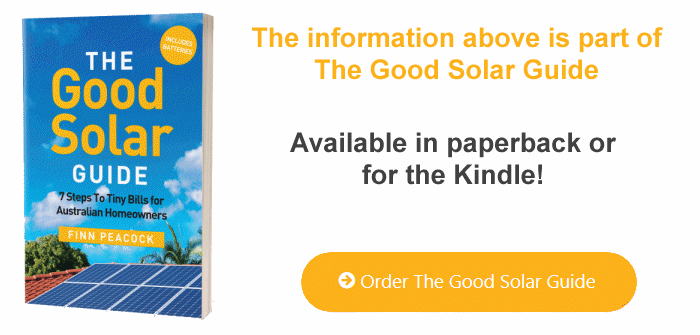STEP 4: Show Me The Money!
← Solar Hot Water Options | The Good Solar Guide Contents | Solar Buying Approaches →
Now it’s time to calculate the optimum size of solar system you need to maximise your returns. In theory, this could get very longwinded. Seriously, I could write War and Peace on this stuff. Hey, I’m an engineer.
In practice, because of the way the solar rebate works, inverter pricing and the overhead involved in ‘rolling a truck’ to do an install, the smallest size most installers will quote for is 3 kW.
And the largest system that most single phase households install – thanks to the local network rules – is 6.6 kW. If you want to go bigger, you’ll need an ‘export limiting’ inverter and special permission from the network, or a three phase supply. If you have a three phase supply and a large enough roof, most people can easily get permission to go up to 20 kW of solar panels.
Sizing your system
At the time of writing, the typical price for a 3 kW, 12-panel system is about $4,500. That’s $1,500 per kW for the first 3 kW of panels.
Online resource: An up-to-date list of ballpark pricing is available here: solarquotes.com.au/cost
The typical price for a 6.6 kW, 24-panel system is $6,500. That means you’re getting an extra 3.6 kW for $2,000. That’s just $550 per kW for the last 3.6 kW of panels. This means that the last 3.6 kW of panels comes at close to a third of the price of the first 3 kW.
Sizing secret: The last 3.6 kW of solar panels can be a third of the price of the first 3 kW.
In terms of sizing your solar power system, this means that, as long as you are getting a reasonable feed-in tariff in your area, you have the space on your roof and you can find an extra $2,000, you’re almost certainly better off getting a 6.6 kW system because it should provide a better return. I’ll show you how to calculate the return so you can confirm this for yourself.
If you plan to heat your water with a heat pump or diverted PV then you should certainly not go smaller than 6.6 kW.
The only parts of Australia where the feed-in tariff is unreasonably low, in my opinion, are some parts of Western Australia, where you have no retailer competition. Here, the feed-in tariff, at the time of writing, is about 7c per kWh.
But I suggest that even you folks in Western Australia should go large because:
- an important benefit of a larger system is increasing self-consumption on cloudy days, and early and late in the day
- you’ll thank me when you get batteries and an electric car in a few years, and
- Western Australia is one of the cheapest places in the country to get solar, so you’ll probably pay less than your non-Westie countrymen and women for your solar power system to start with
Key point: If you have a big enough roof, my advice is to go for at least 6.6 kW of solar panels, no matter where you are in Australia and no matter how small your daytime consumption. It will almost certainly will give you a better return than a smaller system.
If you use more than 14 kWh in the daytime, you should go larger than 6.6 kW if your roof and your DNSP allow.
Am I allowed to add more than 6.6 kW of solar on a single phase supply?
If you have single phase supply, most DNSPs have an inverter size limit of 5 kW.
You’re allowed to oversize your inverter by 33%, so you can have 6.6 kW of panels on that 5 kW inverter.
If you want more than 6.6 kW on a single phase, there is a way round it (DNSP permitting).
Ask your installer about using an 8 kW inverter, export limited to 5 kW. Because it’s an 8 kW inverter, you’re allowed up to 11 kW of panels. It will never send more than 5 kW to the grid, so it is often allowed under the ‘maximum 5 kW’ rules.
Online resource: Many people worry about ‘overloading their inverter’ when the installer suggests a panel array that is larger than the inverter. This link explains why it is actually a really good design option: solarquotes.com.au/xl What system size are you going for?
If your daytime usage is less than 14 kWh per day, and your roof is large enough, I suggest 6.6 kW. If your daytime consumption is more than 14 kWh, then, if your DNSP permits it, you should simply fill your roof with solar up to 10 or 11 kW.
My preferred solar power system size will be _____kW of panels.
Great – now we know what size system we want, it is time to look at the financials.
← Solar Hot Water Options | The Good Solar Guide Contents | Solar Buying Approaches →
Questions or feedback about the content on this page? Contact me.
